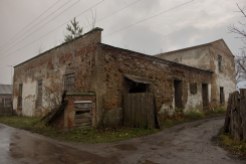Marla, Jay, Vasyl and I are on the road again – the beginning of a four days trip to Jewish heritage sites, mainly in Volhynia. Today, we have been to Radekhiv, Lutsk, Klevan and Rivne.
It started snowing shortly before we left Lviv in northern direction towards Lutsk. We crossed a winter-like landscape but the snow began to melt soon; nevertheless, the day remained cold and gray.
In the town of Radekhiv we were welcomed by Tetyana Sadovska, a local resident involved in the preservation of Radekhiv’s multi-ethnic heritage. In summer, Tetyana and other volunteers have saved the remaining tombstones from the two destroyed Jewish cemeteries of the town. They had been abused to build a path through the Christian cemetery, leading to a Soviet memorial erected over a mass grave. When Tetyana and her friends began to care for the neglected Christian cemetery they found the traces of the Jewish tombstones, until then hidden under a layer of asphalt – and rescued them. Now there is a discussion on what to do with the stones and how to incorporate them into a memorial for Radekhiv’s murdered Jewish community.
Tetyana directed us to the territory of the old Jewish cemetery. Nothing reminds by-passers of the former purpose of the idyllic looking gardens. But people remember. An old lady asked curiously what we were doing here and than told us she remembers the cemetery from her childhood – she used to play there.
We returned to the town’s center, passing the typical Jewish homes around the market and made our way to the former Great Synagogue. The building is empty now but surrounded by busy workshops. What to do with it in the future and how to preserve it is another open question.
Thank you Tetyana, for guiding us! We – and I think I can speak for all in our little group – deeply appreciate what you are doing! Keep going!
Lutsk is famous for its castle but also known for its multi-ethnic mix of population. Ukrainians, Poles, Jews, Karaim and Germans used to live here. The impressive fortress synagogue and other monuments still tell about these times. We passed a former Talmud Torah and the Beit Midrash of Olyka Hasidim. The Beit Midrash underwent big changes and has been transformed to an extend, it is nearly unrecognizable from the main street. A backyard offers a better view but we were send away by a guard.
The town of Klevan is situated close to Rivne. The Jewish cemetery extends over an surprisingly huge territory – mostly empty space but perfectly fenced in. The former Great Synagogue is in a bad state, but the present building is probably to a big extend a post-war construction. Nevertheless, a plaque commemorates the 200 Jews – the plaque says “victims of Fascism” – who were burned alive here by the German occupants. Like other places of the recent trip I got aware of it through the book of Sergey Kravtsov on the synagogues of Volhynia. Sergey, in case you read this: a big thank you!
When we came closer to Rivne, Vasyl recommended to visit the local Holocaust memorial. 17,500 Jews were shot by the Germans in a ravine near the city in November 1941. An impressive memorial was already build in the Soviet era – overlooking this spot of mass killing. What happened here, explains what we saw during the day.

This work is licensed under a Creative Commons Attribution-NonCommercial-NoDerivatives 4.0 International License.



















A wonderful and very fulfilling first day of our road trip!
I do not recall if you’ve mentioned about ever traveling in Podolia in Ukraine?
Lieber Christian the book you recommended by Kai Struve I have and it is a companion to your travel about the happening in the locations you pass it illustrates in no uncertain terms in some details to the fate of the Jewish inhabitants in a gruesome way..As time passes and more of the remainders are being destroyed there will always be a gratitude to your effort in retelling a story in your travel into a vanished- vanishing world.
Thank you for sharing your Lutsk travel. My grandfather was born 1882 in Lutsk .. and married 1904 in Droshkopol .. then moved to Uk. Unfortunately I don’t speak Russian and didn’t ask parents questions when I could have.
how sad that the remnants of vibrant communities are falling away in this manner and only memorials in cemetery is a sign that there were Jews there. Thank you so much for all the work you are doing to prove that these communities contained real people
Thank you for sharing my daughters GGG father Barnat Goldsmith (changed his name to Gannes when coming to America) was born 29 march 1878 in Kovel or Lutsk. His mother’s name was probably Leah Goldsmith and she and her husband were born in Lutsk in about 1858 (still looking for proof and graves)